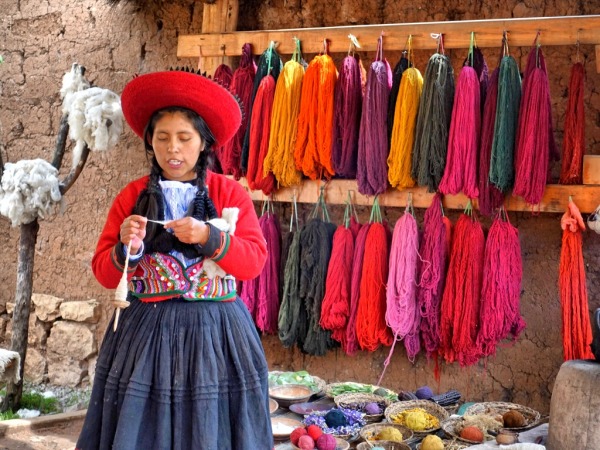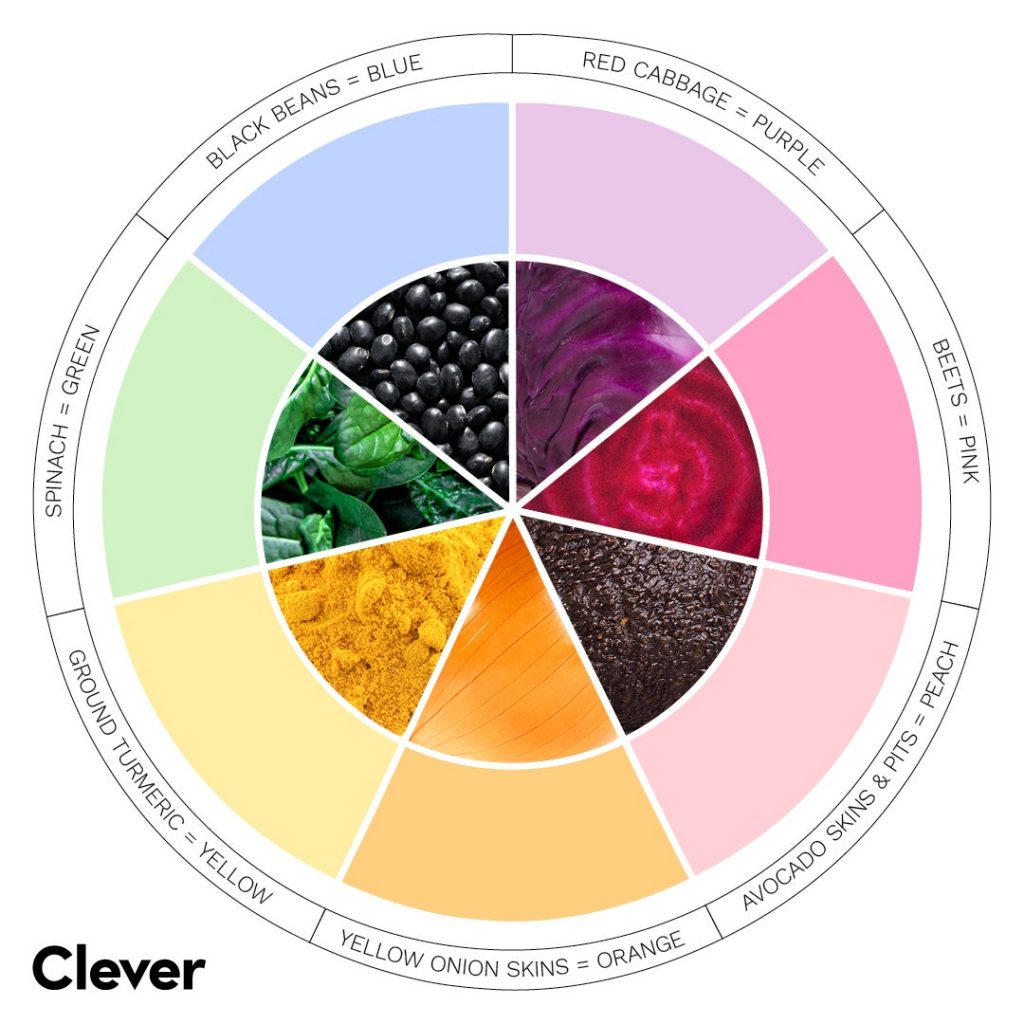On this page you can find:
- Workshop Details for In-Person Participation
- Workshop Details for Remote Participation
- Brief overview about Natural Dyeing
- What foods can be used as dye stuffs?
- Equipment & Supplies (needed for natural dyeing fabric at home)
- Dye Process notes
In-Person Workshop Details*:
When: Saturday, 10/24 @ 1-4PM
Where: Outside Hunt Library
Each student in intro to textile media has one seat reserved in the workshop, to claim your spot please RSVP.
We will provide the fabric and dye stuffs needed for the in-person workshop. You do not need to bring anything – unless you have onion skins or avocado skins & pits to contribute as dye stuffs.
*This is an in-person, outdoor, physically distanced, event. Everyone will need to wear a mask and maintain physical distancing during attendance. Hand sanitizer and sanitizing wipes will be provided.
RSVP here:
http://bit.ly/SoftTech-NaturalDye-Registration
Remote Participation Workshop Details:
It’s possible to do natural dyeing at home – the same that we will be doing at the in-person workshop. Review the list of Equipment and Supplies that you will need for natural dyeing fabric at home. Even though the tools are the same as kitchen equipment you have at home – its very important that you keep your dye tools separate from your cooking tools. Do not use the same tool for cooking that you used for dyeing. There are a few exceptions, noted here. You can dye with the following food items WITHOUT needing separate equipment because all of the ingredients and mordants are all editable and non-toxic (unless you have an allergy to the items):
- onion skins
- tumeric
- avocado skins and pits
- red cabbage
Email orobinso@andrew.cmu.edu to receive zoom link to the workshop.
About Natural Dyeing
Vibrant colors can be achieved using the right techniques that have been evolving since the Neolithic Period. Fabric dying can be done with a wide range of natural materials that can be found right outside your home as well as certain byproducts from food.
The image below shows a Peruvian artisan alongside dyed yarn created from alpaca wool. The article linked below describes the different materials used to dye the fibers as well as some techniques that used by the artisans.

Although many of the dye ingredients use in Peruvian traditions are not easily accessible to us, similar techniques can be used to experiment dying using food items as the natural dye stuffs at home. The key to finding a good food to dye with is knowing which foods contain lots of tannin. This is important to achieve a stronger effect. Tannins create the bitter mouthfeel that results from eating foods such as dark chocolate or grape skins. This bitterness come from the plant’s defense mechanism to keep from getting consumed by animals. In dying, tannin is important.
Here are some examples of products that dye can be extracted from: beet root, avocado seed and peel, coffee grounds, turmeric, pomegranate skins, acorn, oak, rhubarb, tea, walnut, cranberry, cacao, grapes, cranberries, strawberries, blueberries, apples, apricots, peaches, mint, basil, rosemary, black beans, onion skins, and so many more!
Foods as Natural Dye stuffs

Red Dyes: https://www.thesprucecrafts.com/make-natural-fabric-red-dyes-2145745
Orange Dyes: https://www.thesprucecrafts.com/make-natural-orange-dyes-for-fabric-2145746
Yellow Dyes: https://www.thesprucecrafts.com/make-yellow-natural-fabric-dyes-2145748
Green Dyes: https://www.thesprucecrafts.com/make-organic-natural-fabric-dyes-green-2145742
Blue Dyes: https://www.thesprucecrafts.com/make-natural-fabric-blue-dyes-2145738
Purple Dyes: https://www.thesprucecrafts.com/make-natural-fabric-purple-dyes-2145994
Black Dyes: https://www.thesprucecrafts.com/make-organic-natural-black-dyes-2145737
Equipment* & Supplies for Natural Dyeing Fabric (at home)
Supplies:
- Natural Fiber Fabric: Proteine Fibers (wool, silk, alpaca, etc.) or Cellulose Fibers (Cotton, linen, hemp, bamboo, rayon, etc.)
- Mordants: salt for berries (dissolve 1/2 cup salt in 8 cups water), vinegar for other plant material (1 part vinegar to 4 parts cold water)
- Food Stuffs: Choice of food stuffs from above for color choices
- Water
- PPE: gloves, dust mask
Equipment*:
- Stock Pot (stainless steel or glass)
- Heat source (stove, heat plate, etc.)
- Wooden spoon or dowel rod (at least 1/2″)
- Measuring spoons
- Scale (if you have one available)
- Measuring cups
- Drip dry area (such as clothes line or clothes rack, etc.)
* Even though the tools are the same as kitchen equipment you have at home – its very important that you keep your dye tools separate from your cooking tools. Do not use the same tool for cooking that you used for dyeing.
Dye Process Notes
Soaking the Fabric in a Mordant
Fabric should be washed, especially if it is new.
Mordant is another word for dye fixative that helps set the dyes into the fibers. It will both help with intensifying tones as well as help with keeping the dye in the fabric during washes. The type of mordant used affects the shade that the fabric later takes on when it is dyed. Be mindful about the mordant you choose as it will have an effect on your final result!
Berries: Mix salt and water (using the proper ratio). Let the fabric simmer in the pot for about 1-2 hours. Rinse with cool water. Don’t dry it, it needs to be wet for the dyeing process.
Other plant material: Mix vinegar and water (using proper ratio). Let fabric soak in the mixture for a few hours, no boiling for this step.
Making the Dye
The process for extracting dye will be different depending on which product you decide to use. Some dyes can be extracted without boiling, some do require boiling. For this portion of the process, you will have to do a bit of your own research and testing.
Here are some general instructions for extraction:
Fill the pot with twice as much water as plant material. Simmer for an hour or so, until the water has a strong dark color. Strain the plant material out, return the liquid to the pot. This will be the liquid used for dyeing.
Applying the Dye to the Fabric
This may also vary depending on the dyes you have chosen. Some dyes may need to be boiled to attach to the fabric, other dyes may need to soak overnight.
Some general instructions: Place your chosen fabric into the boiling dye bath, let simmer for an hour or so, stir every once in a while. Check the tone of your fabric, keep in mind it will be lighter when it dries. After an hour, turn off the heat and let the fabric sit in the warm water, even overnight if you would like to achieve a richer color. Rinse with cool water and dry.
